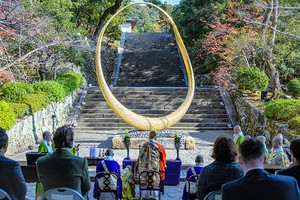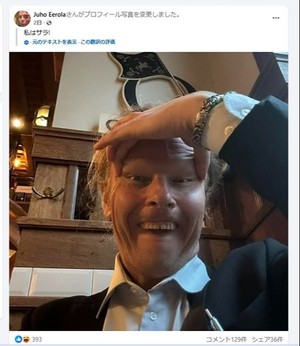By KODAI KINOSHITA/ Staff Writer
January 10, 2022 at 07:00 JST
ZENTSUJI, Kagawa Prefecture--Buddhist pilgrims now have two reassuring companions making their difficult journey easier: the spirit of an ancient Buddhist saint and a high-tech robotic exoskeleton.
In mid-December, a man ascended a slope with ease while generating a smooth mechanical hum. The sight of his robotic exoskeleton drew praise and astonishment from the TV crew filming him.
“The scene was cool and looked like something out of 'RoboCop,'” a cameraman said.
The trekker was outfitted with a control device on his back and motors on his shoulders and waist. He wore a conical straw hat, although the traditional headpiece clashed with the futuristic robotic suit.
It was part of an experiment to see how the machine would fare in supporting the religious pilgrims on the tough terrain. They were walking the “henro” pilgrimage in the Shikoku region to trace the footsteps of Kukai (774-835), a Buddhist priest, also known as Daishi or Kobo Daishi.
After the test was over, a woman in her 50s who climbed a 500-meter slope between two temples with her husband called the technology “marvelous.”
“I was worried about my weak right knee, but I could walk just like healthy people do,” she said.
A man in his 60s also expressed surprise and admiration.
“I could step smoothly without wheezing thanks to the power of this machinery.”
The robotic gear, called Walk Mate, was developed by the Tokyo Institute of Technology.
According to Yoshihiro Miyake, a biophysics professor at the institute who created the mechanical exoskeleton, Walk Mate can add power to a person’s limbs in synch with their pace and gait.
“When people walk with others, they unconsciously try to walk at the same pace as their companions,” Miyake said. “The same idea was incorporated into the robotic suit.”
While Walk Mate has been used in medical centers and elsewhere for physical therapy since 2018, it was only tested for outdoor use for the first time in this recent verification trial.
The experiment took place in Zentsuji, where Kukai hails from. The test used a sloped road that connects the Mandaraji and Shusshakaji temples, which are the 72nd and 73rd destinations along the pilgrimage route.
Asked why the Shikoku henro route was chosen as the first test site, Miyake referred to the notion of “dogyo ninin” (two travel together), in which Kukai is said to accompany pilgrims on their journey regardless of what temple they visit.
“The robot helps users move forward at their own pace,” said Miyake. “I would like users to feel like they are taking trips with Daishi.”
Some devout followers of Buddhism may worry about whether temples would frown on substituting a robotic suit for Kukai. But it has already been recognized by Zentsuji temple, the birthplace of Kukai, as an official “dogyo ninin robot.”
“Daishi is said to dwell inside the walking sticks of pilgrims on henro,” said Chijun Suga, chief priest of Zentsuji temple. “This robot is just a modern technological version of the walking stick.”
After the experiment ended, Suga applied a sticker to the robot that reads “dogyo ninin,” in line with the traditional practice of writing that phrase on pilgrims’ headpieces or other garments.
All Nippon Airways Co. provided support for designing and publicizing the test. The company is considering pitching travel tours in the future so people with weak legs can easily travel this path, thanks to the help of a robotic suit just like Walk Mate.




















A peek through the music industry’s curtain at the producers who harnessed social media to help their idols go global.
A series based on diplomatic documents declassified by Japan’s Foreign Ministry
Here is a collection of first-hand accounts by “hibakusha” atomic bomb survivors.
Cooking experts, chefs and others involved in the field of food introduce their special recipes intertwined with their paths in life.
A series about Japanese-Americans and their memories of World War II